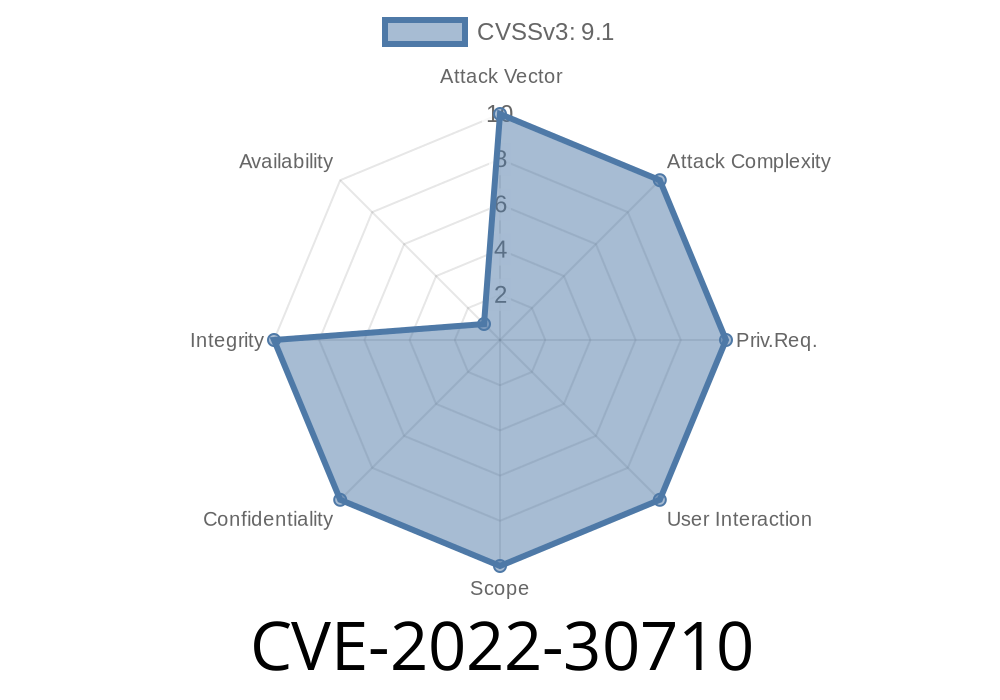A recent vulnerability, classified as CVE-2022-30710, has been identified in the RemoteViews component, affecting versions prior to SMR Jun-2022 Release 1. This vulnerability could potentially allow attackers to launch certain activities and compromise the security of devices that utilize the RemoteViews component. The purpose of this post is to dissect the vulnerability, examine the associated exploit details, and explore potential mitigation steps.
Vulnerability Overview
CVE-2022-30710 is fundamentally an improper validation vulnerability that stems from the RemoteViews component. RemoteViews is a powerful component in Android applications that enables developers to create custom widgets, app-interface elements, and notifications. The vulnerability potentially allows an attacker to gain control of the victim's device by launching specific activities. This can be achieved through the exploitation of the flawed validation of data in the RemoteViews component.
Exploit Details
To better understand the exploit concerning CVE-2022-30710, let's examine the following code snippet, which demonstrates the improper validation of data in RemoteViews:
public class RemoteViewsFactory {
...
public RemoteViews getViewAt(int position) {
if (position < || position >= views.size()) {
return null;
}
RemoteViews remoteViews = views.get(position);
try {
remoteViews.prepareToEnterProcess();
Intent intent = new Intent("com.example.REMOTE_VIEW_ACTION");
PendingIntent pendingIntent = PendingIntent.getBroadcast(context, , intent, );
remoteViews.setOnClickPendingIntent(R.id.widget_button, pendingIntent);
} catch (Exception e) {
Log.e(TAG, "Cannot prepare RemoteViews.", e);
return null;
}
return remoteViews;
}
...
}
In the code snippet above, the getViewAt function retrieves a RemoteViews instance from a list. However, it fails to properly validate the user-provided data before setting a click listener to the PendingIntent. Consequently, this oversight makes it possible for an attacker to tamper with the PendingIntent to execute malicious actions.
The following references dive deeper into the subject of improper validation vulnerability
1. OWASP Top 10 - Insecure Coding Practices: Improper Input Validation
2. Understanding CWE-20: Improper Input Validation
To proactively address CVE-2022-30710, developers should take the following steps
1. Update the RemoteViews component to SMR Jun-2022 Release 1 or later, as the vulnerability has been resolved in these versions.
2. Review and enhance validation routines for all user-provided data within the application. Ensure that you follow secure coding practices, as outlined in resources such as OWASP's Secure Coding Practices Guide.
3. Employ cryptography to protect sensitive data in your application, as detailed in Android's Security and Privacy documentation.
4. Maintain an up-to-date inventory of all third-party components used in your application and monitor them for newly identified vulnerabilities and patches.
Conclusion
In conclusion, the improper validation vulnerability in RemoteViews (CVE-2022-30710) is a critical security threat that requires immediate action. By understanding the vulnerability, its associated exploit, and the corresponding mitigation steps, developers can safeguard their applications and keep their user's data secure. Update to the latest version of RemoteViews and adopt secure coding practices to minimize the risk of future vulnerabilities.
Timeline
Published on: 06/07/2022 18:15:00 UTC
Last modified on: 06/11/2022 01:56:00 UTC
